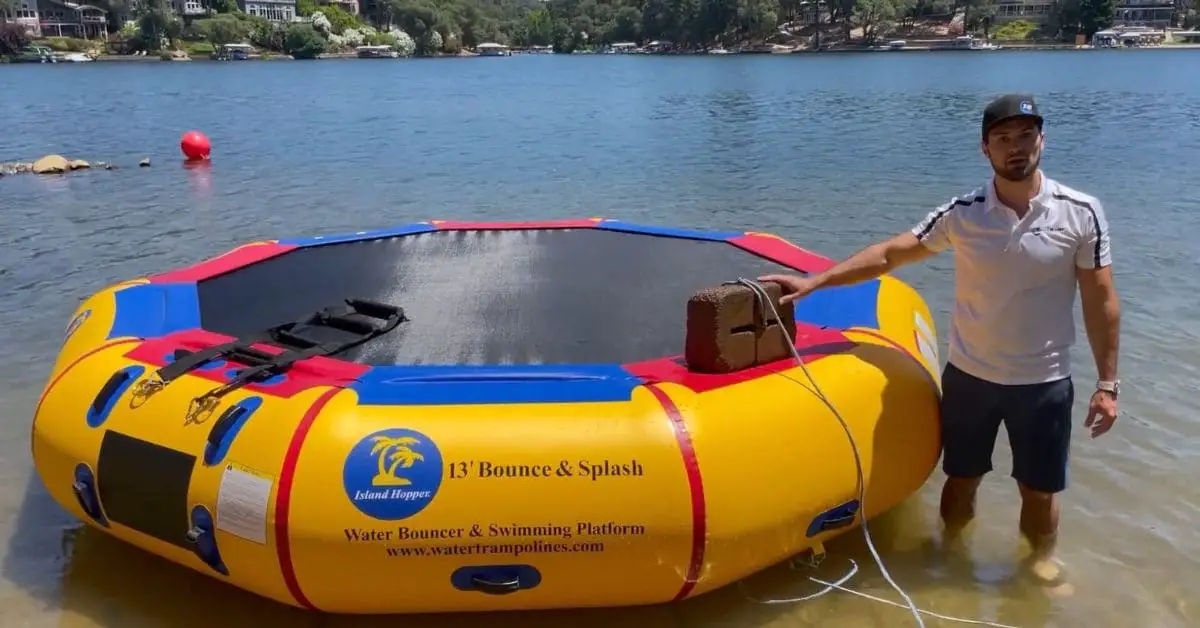If you plan on setting up a water trampoline, one of the most important things to consider is how to properly anchor it. Anchoring your water trampoline correctly is crucial to keep it in place and prevent it from drifting away or flipping over in windy conditions.
As a seasoned water trampoline enthusiast, I’ve learned a thing or two about the best practices for anchoring. In this guide, I’ll walk you through step-by-step instructions for each type of anchor, including sandbags, corkscrew anchors, and mushroom anchors.
I’ll also provide tips on anchoring in different water conditions, such as shallow or deep water and accounting for wind and waves. By the end of this guide, you’ll be equipped with the knowledge and skills to anchor your water trampoline like a pro, ensuring a safe and enjoyable experience for all who use it.
How to anchor a water trampoline: To anchor a water trampoline, start by choosing a suitable location with calm water and a sandy bottom. Then, attach the anchor to the trampoline using a strong rope or chain. Lower the anchor into the water and secure it firmly to prevent the trampoline from drifting away.
Types of anchors for water trampolines
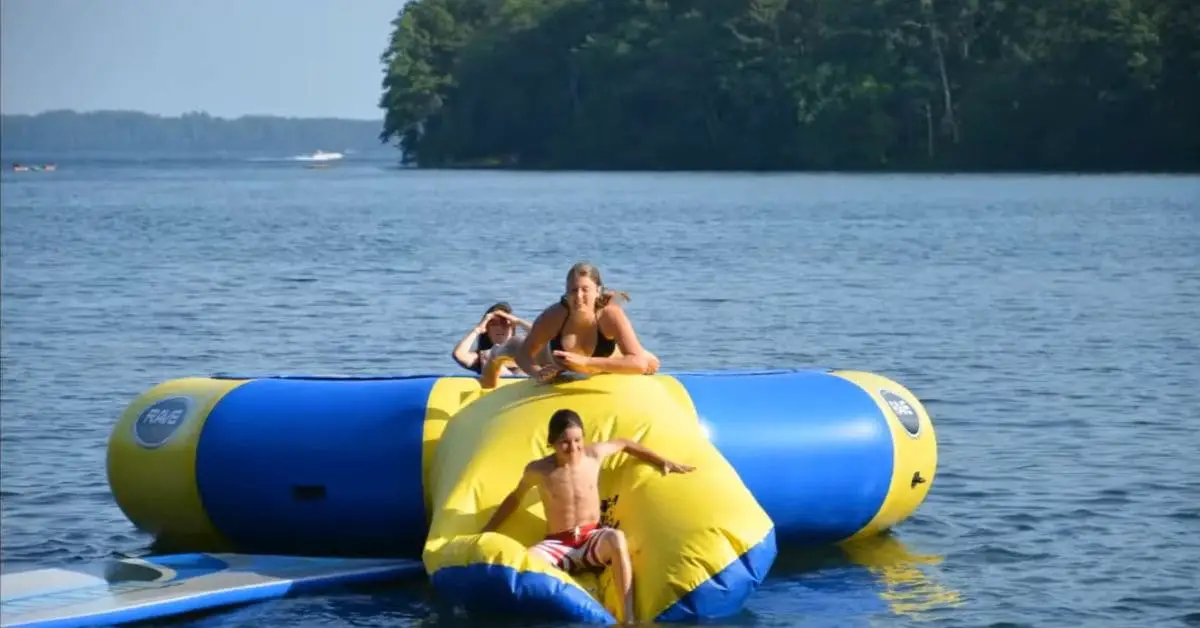
Anchoring a water trampoline is essential for safety as it keeps the trampoline in place and prevents it from drifting away with the current or wind. Various types of anchors can be used for water trampolines, each with its advantages and disadvantages.
Here are the different types of anchors for water trampolines:
Screw-In Anchors
Screw-in anchors are a popular choice for water trampolines as they are easy to install and provide a secure hold. These anchors are screwed into the lakebed or seafloor using a long metal rod with a corkscrew-like end. Once the anchor is fully screwed in, a rope is tied to it, which is used to anchor the water trampoline.
The main advantage of screw-in anchors is that they are very secure and reliable. They are also easy to install and remove, making them an excellent choice for temporary anchoring. However, screw-in anchors are unsuitable for rocky or rugged lakebeds or seafloors and can be challenging to install in areas with dense vegetation.
Sandbags
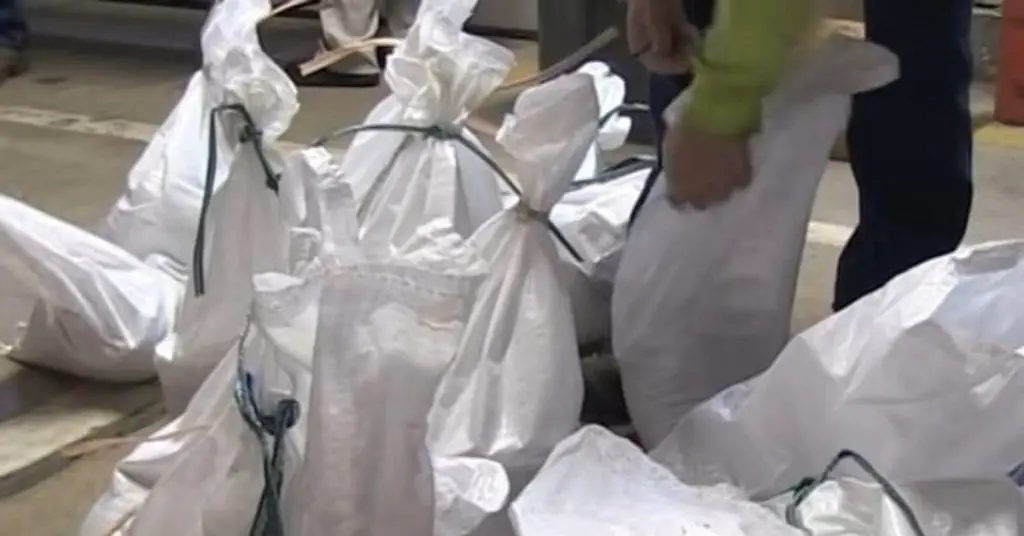
Sandbags are another common choice for anchoring water trampolines. They are inexpensive, easy to transport, and can be filled with sand or gravel to provide weight and stability.
Sandbags are placed around the perimeter of the water trampoline, and a rope is tied to each bag to secure the trampoline in place.
The main advantage of sandbags is their affordability and ease of use. They are also very versatile and can be used in various water conditions. However, sandbags can be heavy and difficult to move, and they can also be affected by currents and waves, which can cause them to shift or move.
Concrete Blocks
Concrete blocks are a heavy-duty option for anchoring water trampolines. These blocks are placed on the lakebed or seafloor and secured with ropes or chains. They provide a stable and secure hold and are ideal for areas with strong currents or winds.
The main advantage of concrete blocks is their stability and durability. They can also be reused multiple times and are not affected by water conditions. However, concrete blocks can be difficult to transport and install and may not be suitable for shallow water areas.
Auger Anchors
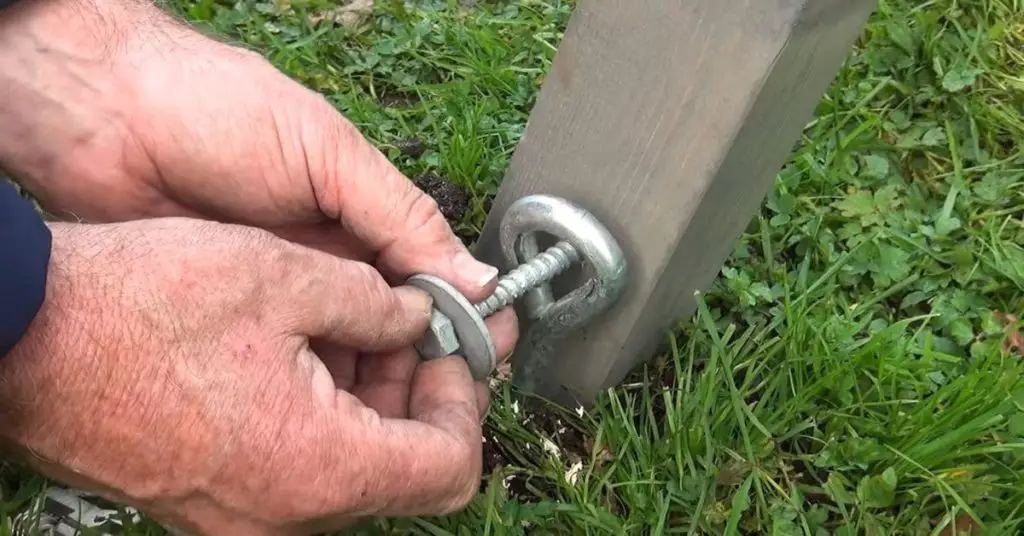
Auger anchors are similar to screw-in anchors but have a corkscrew-like end that can be screwed into sand or mud. Once the anchor is secured, a rope is tied to it and attached to the water trampoline. Auger anchors are suitable for areas with sandy or muddy lakebeds or seafloors.
The main advantage of auger anchors is their ease of use and versatility. They can be used in various water conditions and are also very secure. However, they may not be suitable for hard lakebeds or rocky seafloors.
Water Weights
Water weights are a newer type of anchor that is gaining popularity for water trampolines. These weights are made of PVC or other durable materials and are filled with water. They are placed on the lakebed or seafloor and secured with ropes or chains.
The main advantage of water weights is their ease of use and portability. They are also very versatile and can be used in various water conditions. However, they can be affected by currents and waves, which can cause them to shift or move.
Factors to consider before anchoring
When it comes to anchoring a water trampoline, several important factors must be considered to ensure safety and stability. Here are some of the key considerations to keep in mind:
Water depth:
The water depth where you plan to anchor the trampoline is a crucial factor to consider. If the water is too shallow, the anchor may not hold properly, and the trampoline could easily drift away or tip over.
On the other hand, if the water is too deep, it may be not easy to secure the anchor properly. As a general rule, you should aim for a water depth of at least 8-10 feet.
Type of anchor to use:
The type of anchor you choose will depend on several tours, including the size and weight of your water trampoline, the conditions of the water, and your own tonal preference.
Some common anchors for water trampolines include screw-in anchors, sandbags, concrete blocks, auger anchors, and water weights. Each type of anchor has its strengths and weaknesses, so choosing the one that best suits your needs is important.
Wind and current conditions: Wind and current conditions can significantly impact the stability of your water trampoline.
Before anchoring, it’s important to assess the wind and current patterns in the area and choose an anchor strong enough to withstand those conditions. You should also avoid anchoring in areas where the wind or current is particularly strong or unpredictable.
Distance from shore:
The distance between your water trampoline and the shore is another important factor. If the trampoline is too close to the beach, it may risk drifting into shallow waters or colliding with other boats or watercraft.
On the other hand, it may be not easy to access or maintain if it’s too far from the shore. A good rule of thumb is to anchor your trampoline at least 25-30 feet from the shore.
By considering these factors and choosing the right anchor for your water trampoline, you can ensure that it stays secure and stable, even in challenging conditions.
Remember always to follow the manufacturer’s anchoring and maintenance instructions, and regularly inspect and adjust your anchor as needed. With the proper preparation and care, you can enjoy hours of safe and fun-filled bouncing on your water trampoline.
Equipment needed for anchoring
When anchoring a water trampoline, having the right equipment is essential to ensure that the trampoline stays secure and stable in the water. Here are some of the critical pieces of equipment you’ll need for anchoring:
Anchors:
The anchors are the most critical component of your anchoring system. You’ll use these devices to secure the trampoline to the bottom of the water. Several types of anchors are available, including screw-in anchors, sandbags, concrete blocks, auger anchors, and water weights.
Choose the type of anchor that best suits your needs based on the conditions of the water and the size and weight of your water trampoline.
Ropes or straps:
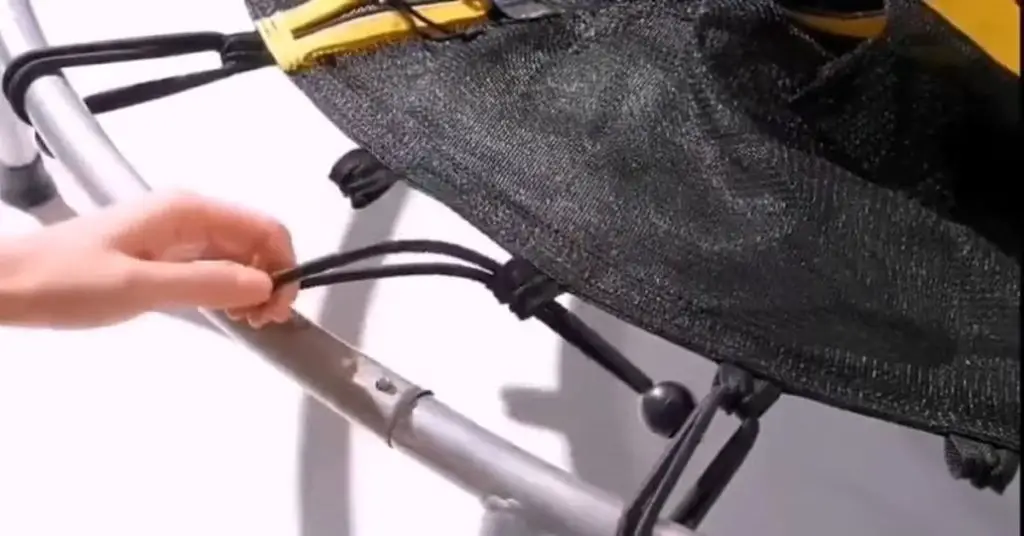
Once you’ve chosen your anchors, you must secure them to your water trampoline using ropes or straps. These will help to keep the trampoline in place and prevent it from drifting away.
Ensure that the ropes or straps are made from solid and durable materials and are rated to handle the weight and size of your water trampoline.
Inflation pump:
Most water trampolines require inflation to stay buoyant in the water. Ensure you have a reliable inflation pump on hand to inflate your trampoline before anchoring it. It’s also a good idea to carry a backup pump or a repair kit in case of any punctures or leaks.
Hammer or mallet:
Depending on the anchor you’re using, you may need a hammer or mallet to secure it properly to the bottom of the water. This is especially true for screw-in and auger anchors, which require some force to penetrate the ground. Ensure you have a sturdy hammer or mallet that can withstand repeated use.
With these critical pieces of equipment on hand, you’ll be well-prepared to safely and securely anchor your water trampoline. Remember always to follow the manufacturer’s instructions for anchoring and maintenance and to inspect your equipment for signs of wear and tear regularly.
With the proper preparation and care, you can enjoy hours of safe and fun-filled bouncing on your water trampoline.
How to anchor a water trampoline?
Anchoring a water trampoline is essential in ensuring safety and stability while enjoying this fun activity on the water. Proper anchoring is essential whether you’re using it for recreational purposes or as part of a commercial operation.
We will provide step-by-step instructions for anchoring a water trampoline using different types of anchors and tips for landing in different water conditions.
Step-by-Step Guide for Each Type of Anchor
Sand Anchors
Sand anchors are a popular choice for anchoring water trampolines, especially if you’re setting up in shallow water. Here’s how to use them:
Step 1: Find a suitable location for your water trampoline. Choose a spot that is relatively flat and free from obstacles like rocks or logs.
Step 2: After finding the perfect location, fill the sand anchor bag with sand. You can use a shovel to scoop up sand from the shore or riverbed.
Step 3: Attach the anchor bag to the anchor line and tie it securely.
Step 4: Take the anchor line to where you want to place your trampoline.
Step 5: Drop the anchor bag into the water and let it sink to the bottom. Make sure the anchor line is long enough to allow the trampoline to float freely on the surface.
Step 6: Secure the anchor line to the trampoline using the provided attachment points.
Screw Anchors
Screw anchors are another popular choice for anchoring water trampolines. Here’s how to use them:
Step 1: Find a suitable location for your water trampoline. Choose a spot that is relatively flat and free from obstacles, like rocks or logs.
Step 2: Screw the anchor into the riverbed or lakebed. You can use a wrench or pliers to turn the anchor if it’s difficult to screw in by hand.
Step 3: Attach the anchor line to the anchor and tie it securely.
Step 4: Take the anchor line to where you want to place your trampoline.
Step 5: Drop the anchor into the water and let it sink to the bottom. Make sure the anchor line is long enough to allow the trampoline to float freely on the surface.
Step 6: Secure the anchor line to the trampoline using the provided attachment points.
Concrete Block Anchors
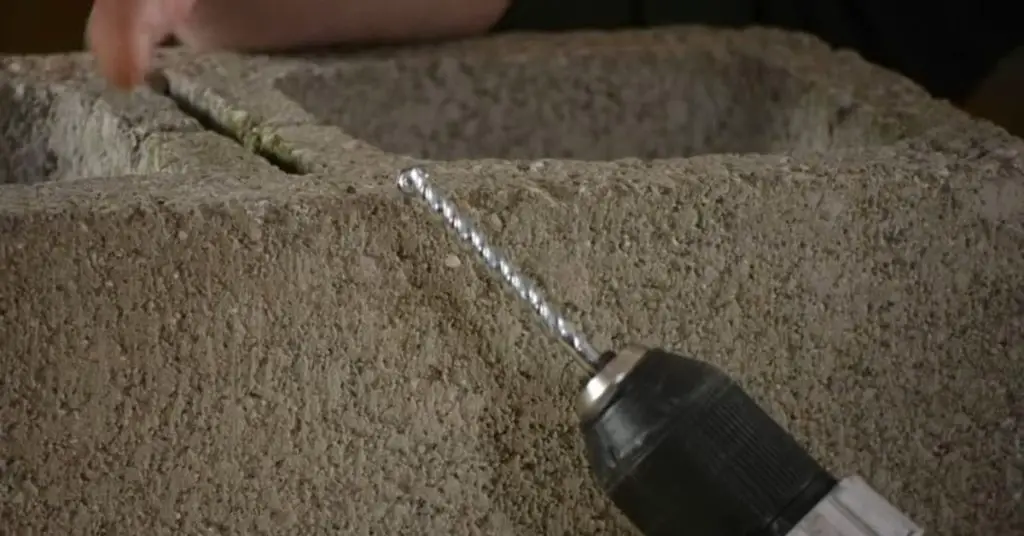
Concrete block anchors are a more permanent option for anchoring water trampolines. Here’s how to use them:
Step 1: Find a suitable location for your water trampoline. Choose a spot that is relatively flat and free from obstacles like rocks or logs.
Step 2: Drop the concrete block anchor into the water and let it sink to the bottom.
Step 3: Attach the anchor line to the anchor, making sure to tie it securely.
Step 4: Take the anchor line out to the location where you want to place your trampoline.
Step 5: Secure the anchor line to the trampoline using the provided attachment points.
Tips for Anchoring in Different Water Conditions
Shallow Water
If you’re setting up your water trampoline in shallow water, it’s important to use sand or screw anchors. These types of anchors are designed for use in shallow water and will provide the necessary stability for your trampoline.
Deep Water
If you’re setting up your water trampoline in deep water, you may want to consider using concrete block anchors. These anchors are designed for use in deeper water and will provide the necessary stability for your trampoline.
Currents
If you’re setting up your water trampoline in an area with strong currents, it’s important to use a strong anchor designed to handle the force of the water. Screw anchors are a good choice for anchoring in currents as they can be screwed into the riverbed or lakebed for added stability.
Windy Conditions
If you’re setting up your water trampoline in windy conditions, using multiple anchors is important. This will help to distribute the trampoline’s weight and prevent it from drifting or flipping over.
You can use sand anchors, screw anchors, or concrete block anchors, depending on the water’s depth and the wind’s strength.
Tidal Areas
If you’re setting up your water trampoline in a tidal area, it’s important to consider the changing water levels. You may need to adjust your anchor points as the tide comes in or goes out. Screw anchors can be a good choice in tidal areas as they can be easily adjusted and repositioned.
How to remove anchors from the water trampoline
Removing anchors from a water trampoline can be tricky, but it’s essential to do it safely and correctly to avoid any damage or injury. This guide will provide a step-by-step guide for removing anchors from a water trampoline.
Step 1: Prepare Your Equipment
Before removing the anchors, ensure you have all the necessary equipment. This includes gloves, pliers, and a wrench or socket set. You may also want a hammer or mallet on hand in case the anchor is difficult to remove.
Step 2: Loosen the Anchor
To remove the anchor, you must first loosen it from the trampoline. Use a wrench or socket set to loosen the bolts or nuts holding the anchor in place. Hold the anchor steady while loosening the bolts or nuts to prevent it from spinning.
Step 3: Remove the Anchor
Once the bolts or nuts are loosened, carefully lift the anchor out of the water. If the anchor is heavy or difficult to lift, you may need a hoist or winch to safely remove it.
Step 4: Clean and Store the Anchor
Once the anchor is removed, clean it thoroughly to remove any debris or salt buildup. This will help to ensure that it is in good condition for future use. You can clean the anchor with a hose and a stiff brush or use a pressure washer if you have one.
After cleaning, dry the anchor completely to prevent rust and corrosion. Once the anchor is dry, store it in a dry, secure location until you can use it again.
Step 5: Repeat the Process for Additional Anchors
If your water trampoline has multiple anchors, repeat the process for each one until all anchors have been removed. Make sure to clean and store each anchor as you remove it.
Step 6: Inspect the Trampoline
After all the anchors have been removed, inspect the trampoline for any damage. Check the frame, springs, and mat to ensure everything is in good condition. If you notice any damage or wear, repairing or replacing the damaged parts may be necessary before using the trampoline again.
Tips for Safe Anchor Removal
- Always wear gloves to protect your hands from sharp edges and rusted metal.
- Make sure to use the right tools for the job. Using the wrong tool can damage the anchor or the trampoline.
- If the anchor is difficult to remove, try tapping it gently with a hammer or mallet to loosen it before lifting it out of the water.
- If you are having trouble removing the anchor, do not force it. This can damage the trampoline or the anchor and may even cause injury.
- Always follow the manufacturer’s instructions for removing anchors and other parts of your water trampoline. If you are unsure about how to remove the anchor, contact the manufacturer for guidance.
How to store anchors when not in use
Anchors are an essential component of any water trampoline setup, but they can take up a lot of space when not in use. Proper storage is important to ensure that the anchors remain in good condition and are ready for use when needed.
We will provide tips for proper storage to prolong the life of your anchors.
Tip 1: Clean and Dry the Anchors
Before storing your anchors, it’s important to clean them thoroughly to remove any dirt, debris, or salt buildup. You can clean the anchors with a hose and a stiff brush or use a pressure washer if you have one. Once the anchors are clean, make sure to dry them completely to prevent rust and corrosion.
Tip 2: Store in a Dry Location
Moisture can cause rust and corrosion, so it’s important to store your anchors in a dry location. This can be a garage, shed, or other covered area that is protected from the elements. Make sure the storage area is well-ventilated to prevent moisture buildup.
Tip 3: Store in a Safe Location
Anchors can be heavy and can cause injury if they fall or tip over. When storing your anchors, make sure to place them in a secure location where they won’t be knocked over or accidentally dropped.
You may want to use a rack or other storage system to keep the anchors organized and easily accessible.
Tip 4: Protect the Anchors from Damage
Anchors can become damaged if they are not stored properly. To prevent damage, make sure to store the anchors in a way that prevents them from coming into contact with other objects. You can use foam padding or other cushioning materials to protect the anchors from scratches or dents.
Tip 5: Inspect the Anchors Regularly
Even when not used, anchors can become damaged or corroded. It’s important to inspect your anchors regularly to ensure that they are still in good condition. Check for signs of rust or corrosion, and make sure that the bolts or nuts are tight and secure.
If you notice any damage or wear, repairing or replacing the anchors may be necessary before using them again.
FAQs
Q.1 Why is it important to anchor a water trampoline?
Anchoring a water trampoline is important for safety reasons. Without proper anchoring, the trampoline can drift away, flip over, or become unstable in windy conditions, potentially causing injury or damage to the trampoline.
Q.2 What types of anchors can be used for a water trampoline?
Several types of anchors can be used for a water trampoline, including sandbags, corkscrew anchors, and mushroom anchors. The type of anchor to use will depend on the water conditions and the trampoline’s weight.
Q.3 How many anchors should I use for my water trampoline?
The number of anchors to use for a water trampoline will depend on the size and water conditions. As a general rule, it’s recommended to use at least four anchors, with one anchor at each corner of the trampoline.
Q.4 What do I do if my water trampoline starts to drift or become unstable?
If your water trampoline starts to drift or become unstable, it’s important to take action immediately. This may involve adjusting the anchors or moving the trampoline to a more sheltered area. If the conditions are too dangerous, removing the trampoline from the water may be necessary.
Q.5 How do I properly maintain my water trampoline anchors?
Proper maintenance of your water trampoline anchors ensures their longevity and effectiveness. This may involve regular cleaning, drying, and inspection for signs of damage or wear. It’s also important to store the anchors properly when not in use to prevent rust and corrosion.
Conclusion
In conclusion, anchoring a water trampoline is essential for ensuring the safety and enjoyment of those using it. The different types of anchors available, including screw-in anchors, sandbags, concrete blocks, auger anchors, and water weights, provide various options depending on the location and water conditions.
Before anchoring, factors such as water depth, distance from shore, and the type of anchor to use must be considered. Equipment required for anchoring includes anchors, ropes or straps, an inflation pump, and a hammer or mallet.
A step-by-step guide for each type of anchor and tips for anchoring in different water conditions were also discussed. To remove anchors, proper equipment and techniques must be used to prevent damage to the trampoline.
Storing anchors when not in use is also essential to ensure their longevity and effectiveness. By following the tips provided, beginners can successfully anchor their water trampoline and enjoy a safe and fun experience on the water.
After reading this detailed guide on how to anchor a water trampoline, we hope you understand how to do it properly. If you have any questions, please leave a comment below and we’ll be happy to help!

